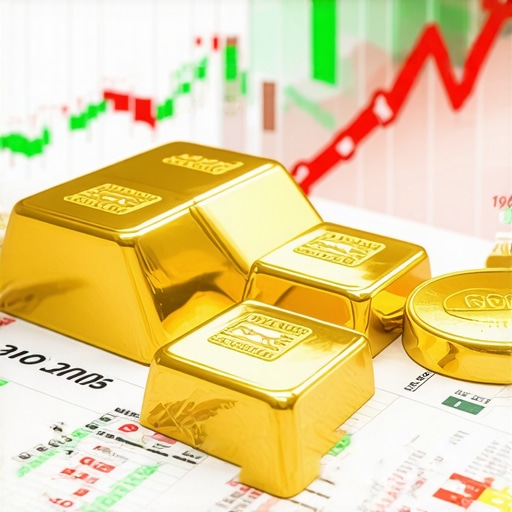Understanding the Complex Dynamics of Gold Demand and Its Impact on Prices in 2025
As global economies navigate unprecedented shifts in economic stability and geopolitical tensions, the demand for gold continues to serve as a vital barometer for investor confidence and macroeconomic resilience. Recognized for its dual role as a safe-haven asset and a strategic commodity, gold’s demand fluctuations in 2025 are shaping market prices with nuanced implications rooted in supply chain dynamics, technological integration, and evolving consumer behavior.
What Are the Key Drivers Behind Gold Demand in 2025?
In 2025, the multifaceted demand for gold is influenced by a confluence of factors: central bank policies, jewelry industry trends, technological advancements, and investment strategies. Central banks’ accumulated reserves and their purchase patterns—detailed in recent gold market analyses—highlight a strategic shift towards diversification amid inflationary pressures. Meanwhile, the jewelry and tech sectors are witnessing supply chain adjustments that alter demand in both traditional and emerging markets.
Furthermore, the proliferation of digital gold investment options and ETFs has diversified demand profiles, making it essential for investors to understand how these trends influence gold prices. For expert strategies on building a secure gold portfolio in 2025, see building a diversified gold investment portfolio.
How Do Supply-Side Factors Interact with Demand to Affect Prices?
Supply constraints, notably in gold mining output and recycling processes, interact with demand fluctuations to influence pricing trajectories. Analyzing the drivers of gold prices reveals that geopolitical tensions, regulatory changes, and technological innovations in extraction methods are pivotal in shaping supply. These factors, coupled with robust demand in sectors like jewelry and industry, create a complex market landscape where pricing signals are often delayed or amplified.
Investors seeking to navigate these intricacies should consider comprehensive market analysis and technical trading strategies, such as those outlined in mastering gold trading with technical analysis.
How Can Market Participants Leverage Demand Trends for Strategic Advantage?
Market participants can leverage insights into demand trends by integrating macroeconomic forecasts, industry consumption patterns, and central bank policies. For example, understanding the role of gold in inflation hedging can guide portfolio adjustments, as discussed in using gold as a hedge in 2025. Additionally, engaging with expert content on investment strategies for 2025 can enhance decision-making and risk management.
For a comprehensive overview of demand-supply dynamics and their impact on prices, consult recent analyses from the International Monetary Fund.
Explore more about how to adapt your investment approach to these evolving trends by visiting our ultimate guide to investing in gold coins.
Deciphering the Future of Gold Demand: What Are the Hidden Influencers in 2025?
As we delve deeper into the economic landscape of 2025, it becomes clear that understanding the nuanced drivers of gold demand is essential for savvy investors. Beyond traditional factors like jewelry and central bank reserves, emerging trends such as digital gold platforms, geopolitical stability, and technological innovations in mining are reshaping the market. For instance, the rise of digital gold investments has diversified demand profiles, offering new opportunities for portfolio diversification. How might these less obvious factors influence gold prices in the coming months? Analyzing these shifts through expert frameworks enables investors to anticipate market movements more accurately and craft resilient strategies.
Are Supply Chain Disruptions and Technological Advances Creating a New Equilibrium in Gold Pricing?
Supply-side constraints, driven by geopolitical tensions, environmental regulations, and technological advancements in extraction, are fundamentally altering gold’s scarcity dynamics. The interaction between mining output, recycling rates, and technological efficiencies determines the supply available to meet demand. According to recent market analyses, these factors contribute to increased price volatility but also create opportunities for strategic timing in buying and selling. Investors utilizing technical analysis tools, such as trend indicators and volume patterns outlined in gold trading strategies, can better navigate these complexities.
How Can Investors Leverage Evolving Demand Trends to Optimize Portfolio Performance?
Capitalizing on demand shifts requires a comprehensive understanding of macroeconomic indicators, monetary policies, and consumer behavior. For example, as inflation fears persist, gold’s role as a hedge becomes more prominent, necessitating adjustments in investment allocations. Engaging with in-depth analyses from trusted sources like the International Monetary Fund can provide critical insights into global reserve trends and policy shifts. Furthermore, diversifying through vehicles like gold ETFs and mutual funds allows for flexible exposure and risk management. What are your thoughts on integrating these advanced strategies into your investment approach? Consider sharing your experiences or seeking tailored advice to enhance your gold investment success in 2025.
Innovative Perspectives on Gold Market Equilibrium Amid Evolving Technologies
As we delve deeper into the complexities of the gold market in 2025, it becomes evident that technological advancements are not merely reshaping mining efficiencies but also fundamentally altering the supply-demand paradigm. The advent of AI-driven exploration algorithms and blockchain-enabled traceability has enhanced transparency and reduced costs, potentially increasing supply while simultaneously influencing investor confidence. According to a recent report by the World Gold Council, these innovations could lead to a more balanced market, yet introduce new volatility patterns driven by technological adoption rates across different regions.
Furthermore, the integration of these technologies fosters sustainable mining practices, which are increasingly demanded by environmentally conscious investors. The confluence of supply chain transparency and sustainable operations may shift the market’s perception of gold’s scarcity and value, influencing pricing dynamics in unprecedented ways.
How Do Technological Innovations Impact Gold’s Scarcity and Price Volatility?
Emerging technologies such as remote sensing, machine learning, and automation are streamlining extraction processes, reducing costs, and opening access to previously inaccessible deposits. However, these advancements also create a paradox: while they may increase short-term supply, the market’s perception of scarcity is influenced by the accelerated verification and traceability process, which can lead to sudden shifts in demand. This phenomenon is explored in detail in the IMF’s recent analysis, emphasizing the importance of investor awareness of technological impacts on market fundamentals.
Understanding these dynamics allows investors to anticipate potential price swings, especially when technological breakthroughs are announced or adopted at scale. Strategic positioning, therefore, requires a keen grasp of both technological trends and traditional market indicators.
What Strategic Approaches Can Investors Adopt to Navigate Tech-Driven Market Changes?
Advanced investors are increasingly leveraging predictive analytics and real-time data feeds to stay ahead of market shifts. Incorporating algorithms that analyze supply chain disruptions, technological adoption rates, and geopolitical influences can provide a competitive edge. For example, engaging with platforms that integrate AI-driven forecasts—like those offered by GoldTech Insights—can help refine entry and exit points in gold trading.
Additionally, diversifying across physical gold, ETFs, and innovative digital gold platforms can hedge against volatility and capitalize on emerging opportunities. The key is to balance technological insights with traditional risk management strategies, ensuring resilience in turbulent times.
Interested in implementing these advanced strategies in your portfolio? Consider consulting with a financial advisor specialized in precious metals and technological market analysis to tailor a plan aligned with your investment goals.

Decoding the Role of Institutional Investors in Gold Market Volatility
In 2025, institutional investors such as hedge funds, pension funds, and sovereign wealth funds are increasingly influencing gold prices through strategic positioning and large-scale transactions. Their portfolio shifts, driven by macroeconomic forecasts and geopolitical considerations, can trigger significant volatility, as discussed in the IMF’s recent report on institutional investment patterns. Understanding their motives and timing is crucial for sophisticated investors aiming to anticipate price swings and capitalize on opportunities.
Emerging Technologies Reshaping Gold Market Transparency and Pricing
The integration of blockchain technology and AI-driven analytics is revolutionizing transparency in gold supply chains, fostering trust and reducing fraud. As detailed in the World Gold Council’s latest report, these innovations are not only improving traceability but also influencing market perceptions of scarcity and value. This tech-driven transparency can lead to more accurate pricing models and new hedging strategies for market participants.
What Are the Cutting-Edge Analytical Tools for Gold Market Forecasting?
Advanced investors leverage predictive analytics platforms that incorporate machine learning algorithms, sentiment analysis, and real-time geopolitical data to forecast gold price movements with higher precision. Tools such as Gold Analytics Platform exemplify this trend, offering nuanced insights into market sentiment and supply-demand imbalances. Mastery of these tools can provide a significant edge in executing timely trades and managing risk effectively.
How Can Investors Integrate Multidimensional Data for Strategic Gold Investment?
Integrating macroeconomic indicators, technological developments, and geopolitical risk assessments enables a holistic view of market dynamics. For example, monitoring central bank reserve changes, technological advancements in mining, and geopolitical stability indices can inform more refined entry and exit strategies. As emphasized in the IMF’s global market analysis, a multidimensional approach enhances resilience and profitability in volatile environments.
Exploring Sustainable and Ethical Gold Investment in 2025
With increasing emphasis on environmental, social, and governance (ESG) criteria, investors are prioritizing sustainably sourced gold. Innovations in eco-friendly mining practices and blockchain traceability are setting new standards for responsible investing. According to the World Gold Council’s sustainability report, aligning investments with ESG principles not only mitigates reputational risks but also taps into a growing segment of ethical investors seeking transparency and social impact.
To stay ahead in this evolving landscape, consider engaging with specialized consultancies and technological platforms that focus on sustainable gold sourcing and advanced market analytics. Your proactive approach could redefine your investment success in 2025 and beyond.

Expert Insights & Advanced Considerations
1. Market Transparency Through Technology
Emerging blockchain and AI-driven analytics are revolutionizing gold market transparency, reducing fraud, and enabling precise supply-demand assessments, which are crucial for strategic decision-making.
2. Central Bank Policies as Market Catalysts
Central banks’ gold reserve adjustments serve as significant indicators, influencing investor confidence and market volatility; understanding these patterns enhances predictive accuracy.
3. Technological Innovation Impact
Innovations like remote sensing and automation are reshaping mining efficiency and supply dynamics, potentially leading to shifts in scarcity perceptions and pricing volatility.
4. Diversified Investment Strategies
Incorporating digital gold, ETFs, and traditional physical holdings can optimize portfolio resilience amidst evolving market conditions.
5. Institutional Market Influence
Large-scale transactions by institutional investors can trigger volatility; monitoring their movements offers strategic advantages for informed trading.
Curated Expert Resources
- World Gold Council Reports: Offers comprehensive insights into technological advancements, sustainability, and market trends shaping gold’s future.
- IMF Gold Market Analysis: Provides macroeconomic context and detailed analysis of supply-demand interactions and policy impacts.
- GoldTech Insights Platform: Features AI-driven forecasts and supply chain analytics, essential for high-level trading strategies.
- Official Central Bank Reserve Reports: Critical for understanding reserve trends and geopolitical influences.
- Academic Journals on Precious Metals: For deep dives into technological, economic, and environmental factors affecting gold markets.
Final Expert Perspective
Understanding the nuanced dynamics of gold demand and market trends in 2025 requires a synthesis of technological innovations, macroeconomic policies, and institutional behaviors. As market transparency improves through blockchain and AI tools, and central banks continue strategic reserve adjustments, investors must adapt with diversified, data-driven strategies. Engaging deeply with authoritative resources such as the World Gold Council and IMF reports will empower sophisticated decision-making. For those committed to optimizing their gold investments in this evolving landscape, continuous learning and strategic agility are paramount. Explore more advanced approaches and deepen your expertise by visiting our detailed guides on best gold investment strategies for 2025 or top types of gold investments in 2025. Your proactive engagement today sets the foundation for resilient wealth preservation tomorrow.











This article offers a thorough view of the intricate factors influencing gold prices in 2025. I’ve been exploring how technological innovation, like blockchain, is not only enhancing transparency but also potentially stabilizing prices by reducing fraud and speculative manipulation. The role of institutional investors in market volatility is particularly interesting; their large transactions can certainly sway the market, but it’s reassuring to see that advanced analytics are helping traders better anticipate these moves. I wonder, with such rapid technological shifts, how do small retail investors effectively stay informed and adapt their strategies? Do others find that diversifying across physical gold, ETFs, and digital platforms offers enough resilience against volatility, or are there additional tools or approaches that have worked well for you? It seems that continuous learning and leveraging data-driven insights are becoming essential for everyone involved in the gold market today.